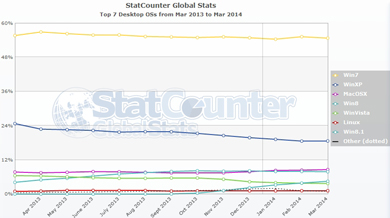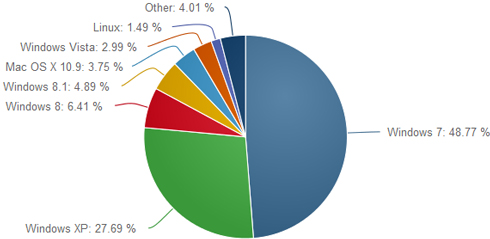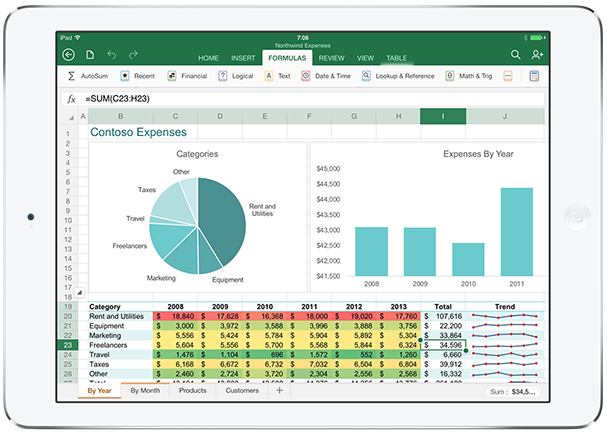StorageCraft Technology Corp. recently overhauled its portal for managed service provider partners.
The new StorageCraft MSP Portal is part of the StorageCraft Profit-Ability Partner Program and includes user interface enhancements, as well as new tools for MSPs to manage StorageCraft licenses through an Apple iPad, Microsoft Surface or other tablet.

Draper, Utah-based StorageCraft makes its Profit-Ability Partner Program available to partners at no charge. The program includes marketing development funds, deal registration, marketing and sales collateral, technical training, not-for-resale software, training, lead sharing and sales incentives, among other benefits.
StorageCraft currently has more than 4,000 current MSP partners and its flagship product for backup, disaster recovery and data protection covers more than 200,000 servers through monthly subscriptions.
The company's OEM partners include the professional services automation companies Autotask Corp. and ConnectWise and the remote monitoring and management companies LabTech Software, N-able by SolarWinds, AVG Managed Workplace, Continuum and Kaseya. Backup and disaster recovery providers using StorageCraft technology include Advanced Backup Solutions, Datto Inc., CharTec and eFolder.
Posted by Scott Bekker on May 05, 20140 comments
A prominent remote monitoring and management (RMM) provider is taking a first step toward packaging Infrastructure as a Service to make IaaS friendlier for SMB customers and easier for MSPs to deploy and manage.
Continuum this week launched Continuum Cloud Console, or C3. Billed as an IaaS management platform, C3 is delivered as a tab in Boston-based Continuum's SaaS-based RMM system.
CEO Michael George positioned the offering as a way for Continuum's 3,300 MSP partners to remain relevant despite cloud's disruptions to the IT services industry. "With the launch of C3, Continuum is making it possible for MSPs to deliver cloud technology very efficiently to its clients and at the client's pace and readiness, making them relevant in today's cloud economy and solidifying the future of the channel," George said in a statement.
While Continuum recently unveiled a major upgrade to its datacenter capacity, the new offering does not represent an attempt to create a new IaaS offering from scratch for MSPs to offer. Instead, the company is focused on managing existing IaaS offerings, with tools to help MSPs launch virtual machines for customers on those services using only the components SMBs would typically need.
"We're initially launching using Amazon Web Services but we do plan on adding other vendors soon," said Sarah Galler, C3 product manager, in a video demo on the Continuum site.
In her demo, Galler walked through the process of creating a new virtual cloud and virtual machine on the Amazon service, complete with configuring the virtual servers and entering credit card information.
Posted by Scott Bekker on May 01, 20140 comments
It's getting to be that time of year again -- for RCP Rocket Award submissions.
Have a great growth story? You've got a little over a month until the June 1 submissions deadline to send us the details. We're looking for a one- to two-page description of the innovative business strategies you've used that have resulted in sustained growth over a three-year period.
The 2014 award is open to all U.S.-based IT services companies with annual revenues between $5 million and $75 million. Click here for more contest details or e-mail me with your questions.
For an example of the kind of growth strategies that led to a win in the inaugural contest last year, here's our profile from October 2013 of one of the three winners:
2013 RCP Rocket Award Winner Profile: IntelliNet Corp.
In mid-2010, Atlanta-based IntelliNet Corp. was struggling. A tough recession in the technology services industry and a strategic plan that had not kept up with the changing marketplace had plagued the firm's productivity.
While IntelliNet was a highly regarded firm with over 40 regional, national and worldwide Microsoft awards, revenue had fallen flat and was beginning to decline. Some years were profitable, while other years operated at a loss, resulting in a break-even business. Over the years, employee morale suffered and IntelliNet faced a crisis of identity and performance.
"When the recession hit and IntelliNet experienced operating losses in the first half of 2010, the Board evaluated the company's viability and realized if IntelliNet was going to thrive once again, it needed to reposition its go-to-market strategy, management team and overall operations," said Frank Bell, founder and chairman of the 20-year-old Microsoft-centric technology services firm.
For that task, the company tapped an internal executive to become its new president and senior partner. Mark Seeley had joined IntelliNet in 1996, just a few years after the systems integration firm was founded. In addition to his experience with internal operations and key IntelliNet accounts, Seeley was a proven entrepreneur, trained in strategy and process consulting from Andersen Consulting, who garnered respect from fellow executives as a strategic thinker and business-minded leader.
Seeley and his management team got right to work. The company had strong brand recognition as a result of over 5,000 client engagements in over 40 states with a great reputation for service, and also boasted a world-class profile within the Microsoft ecosystem with multiple Microsoft "Worldwide Solution of the Year" awards.
 Mark Seeley took over as president and senior partner of Intellinet Corp. in 2010 and focused the company on a new five-pillar strategy.
Mark Seeley took over as president and senior partner of Intellinet Corp. in 2010 and focused the company on a new five-pillar strategy.
Seeley concentrated on the need for a long-term growth strategy beyond the company's core systems integration work. He and his management team laid out a five-year, five-pillar plan to carry the company forward and meet clients' future needs. The pillars were Technology Projects, Management Consulting, Cloud Solutions, Product Integration and the IntelliNet Delivery Center.
Technology Projects and Product Integration grew naturally out of the company's historical business, and Seeley created a new internal review committee to ensure all projects met business requirements and used or created repeatable assets. Crucial, however, to IntelliNet's strategic transformation was its move upstream to "lead with Management Consulting" -- a business alignment philosophy making IntelliNet more strategic and valuable to its huge client base.
IntelliNet also doubled down on its early efforts in Cloud Solutions, mirroring the 2010 Microsoft Worldwide Partner Conference messaging of "we're all in" from Microsoft, having already brought over 75,000 seats to the early Microsoft cloud. IntelliNet saw the opportunity within the cloud and became an early Microsoft Cloud Accelerate partner. The final piece to Seeley's vision involved creating a new IntelliNet Delivery Center, which would serve as the foundation for large-scale development projects and its managed services offerings.
"These five pillars have proven to be a successful strategy for our firm. The second half of 2010 brought about a new go-to-market strategy, financial stability and a purposeful initiative to become a world-class consultancy," Seeley said. "In 2011, revenue increased 11 percent and operating profit increased 810 percent. In 2012, revenue increased 26 percent and operating profit increased 83 percent. The growth in core services, as well as the additional gross profit provided by product incentives and stronger partnerships, have provided a strong foundation for IntelliNet's further expansion into new regions and targeted acquisitions of other regional service providers."
"Throughout our turnaround and subsequent growth, we have remained committed to building a best-in-class company culture," Seeley stated. IntelliNet has racked up over a dozen awards in the past three years, including having been named a 2013 "Best Small Firms to Work For" by Consulting Magazine. "This recognition validates the hard work in pursuing our vision of being a 'profitable, growing company that delights customers and provides an excellent experience for our employees.'"
With a solid focus on cloud solutions and linking all technology projects to their underlying business objectives, IntelliNet has delivered 32 consecutive months of profitability and counting, and seems poised for strong growth in years four and five of the plan.
Posted by Scott Bekker on April 28, 20140 comments
A good portion of the Microsoft channel is already involved with management, integration and app development for the Apple iOS ecosystem.
With the rollout of the long-awaited Office for iPad in late March, Microsoft finally created a clear bridge for its partners between the Microsoft world that they know well and the huge customer demand for business apps on the world's most dominant tablet.
On an earnings call last night, Apple executives provided some metrics and context that clarified how potentially huge that iPad opportunity could be for Microsoft partners.
Apple CEO Tim Cook, who Tweeted a welcome when Microsoft brought Office to the App Store, enthused some more in response to a financial analyst's question.
"There [are a lot] of alternatives out there from a productivity point of view, some of which we brought to the market, some of which many, many innovative companies have brought," Cook said first in a nod to Apple's own Keynote, Pages and Numbers and the numerous apps that sprang up to meet demand for Office compatibility as former Microsoft CEO Steve Ballmer played Hamlet on whether Office should be or not be in the App Store.
"But I do see that Office is still a very key franchise in the enterprise, in particular. And I think having it on iPad is good, and I wholeheartedly welcome Microsoft to the App Store to sell Office. Our customers are clearly responding in a good way that it's available. So I do think it helps us particularly in the enterprise area," Cook said (quotes courtesy of the Seeking Alpha transcript).

As for Microsoft's lengthy wait before bringing Office to the iPad, Cook was critical. "I believe if it would have been done earlier, it would have been even better for Microsoft, frankly."
Timing aside, an opportunity for Microsoft is an opportunity for Microsoft partners. Some of the numbers and anecdotes shared during the Apple earnings call illustrated what a whopper of an opportunity Office on iPad could be.
First, there's the installed base, which presents opportunities for new Office 365 subscription sales and for new conversations to make sure existing customers are using their subscriptions to light up the free Office for iPad apps.
That installed base is huge. Cook said that Apple has sold 210 million units in the four years since launching the iPad. There was some concern about a sales drop in iPad units from the year-ago quarter to this one, but Apple executives explained most of it away as a channel backlog issue with iPad sell-through trending at nearly the same pace as the year before. Meanwhile, Apple had some very strong numbers to report from emerging markets. Apple probably won't be as dominant in tablets in the next few years, but it is likely to remain dominant for a while.
All those iPads, iPad Airs and iPad minis aren't just sitting in people's living rooms, either. Cook claimed 98 percent of Fortune 500 companies use iPad in some capacity and said, "According to Good Technology, who looks at activation of tablets, the latest data we have from them is that 91 percent of activation of tablets in enterprise were iPads."
There's more than a breadth opportunity in Office 365 subscriptions. All along, some partners have taken advantage of the general iOS development opportunity. Now that opportunity is greatly expanded by the ability to create custom corporate apps that integrate with Office -- something that's right in many Microsoft partners' wheelhouse.
That depth was evident as Luca Maestri, vice president of finance and corporate controller for Apple, read through a laundry list of huge customers using iPads. The raw numbers deployed were impressive, such as 20,000 iPads at Eli Lilly and 11,000 units at the U.S. Department of Veterans Affairs. The Eli Lilly example was especially interesting because the company has deployed 50 internal apps as part of a laptop replacement program. (Some enterprises have similarly huge iOS internal app counts primarily for iPhone: 40 at Deutsche Bank and 50 for Siemens.)
The amount of repeatable business that could be available to partners who successfully develop IP and best practices around custom iOS apps leveraging Office for iPad is potentially massive.
Having a clean version of Office available for iPad makes the Microsoft partner opportunities much clearer, and Apple's impressive ability to keep driving huge volumes of tablet sales makes those clear opportunities big.
Posted by Scott Bekker on April 24, 20140 comments
Microsoft on Monday unveiled the latest results of its eternal tinkering with the machinery designed to get partners selling cloud.
In a blog post, Thomas Hansen, vice president of Small and Medium Business for Microsoft Worldwide SMS&P, revealed Cloud SureStep, a business advice and tools program with three pillars based on the maturity level of a partner's cloud business.
"We've heard from many of you that moving your business to the cloud has presented a number of challenges, such as making the initial move with the least impact, knowing where to go for assistance and maximizing business efficiency once you're migrated," Hansen wrote.
The idea of Cloud SureStep is a "one-stop resource built within our MPN website," Hansen said. The three parts of Cloud SureStep are Getting Started, Grow Your Cloud Business and Optimize Your Cloud Business.
Getting Started includes IDC market overviews, pointers to videos about profitability and links to the Online Services Advisor incentives guide and other resources. The Grow Your Cloud Business section includes information on earning a competency or joining the SMB Cloud Champions Club. The Optimize section focuses on differentiation through offerings of multiple Microsoft cloud and/or on-premise products together.
Hansen said Cloud SureStep is beginning with Office 365 and Windows Intune and will add resources for Microsoft Azure and Microsoft Dynamics CRM Online in the next few months.
The Cloud SureStep page is here.
Posted by Scott Bekker on April 21, 20140 comments
Kaseya, the midmarket-focused systems management company that counts MSPs as a major part of its customer base, is rebranding itself as the IT Management Cloud Company.
President and CEO Yogesh Gupta discussed the rebranding with RCP in a telephone interview this week from Kaseya Connect, the company's gathering of customers and partners in Las Vegas.
Gupta announced the rebranding and updated the company's product roadmap at the show.
"Management is happening more and more in the cloud," Gupta said. He described cloud management for Kaseya as having two meanings. One refers to management technology existing as a cloud service. The other has to do with integrating the management of third-party online services into Kaseya's offerings. Gupta mentioned several prominent examples of cloud services that customers need to have managed, including Microsoft's Azure, Amazon Web Services and Office 365, a suite Kaseya took a major step to manage last year with the acquisition of 365 Command.
 Kaseya CEO Yogesh Gupta at Kaseya Connect. (Source: Kaseya)
Kaseya CEO Yogesh Gupta at Kaseya Connect. (Source: Kaseya)
Kaseya's new cloud vision represents another major initiative in the energetic tenure of Gupta, a former executive at CA and Fatwire Software who joined Kaseya in June when Insight Venture Partners invested in the company. In his first few months at Kaseya, Gupta introduced a new agile development process and oversaw the acquisitions of Rover Apps, Zyrion Inc. and 365 Command.
Gupta promised that although the cloud orientation is now strategic for Kaseya, no MSPs or midmarket customers will be forced to move from Kaseya's traditional on-premises tools until they're ready.
"My goal is to not force our customers to move off of the on-prem platform at all. The capabilities of what we offer in the cloud versus on-prem will be the same," Gupta said. "We will make it so I think they will want to move there. I don't see us forcing our customers. I actually think that they'll be pulled."
Some of the benefits Gupta said cloud platform customers will see include rapid and seamless security updates, a reduction in costs due to eliminating hardware and software licensing for on-premises management suite deployments, and the ability to view anonymous, aggregate performance data from other Kaseya customers that will provide early warnings on geographical issues or broadband service provider outages. At the same time, Gupta said Kaseya will work to protect MSP and customer investments in agent procedures, scripts and other customizations by providing upgrade paths to the cloud versions.
As for being pulled to the cloud, Gupta offered Kaseya itself as an example. "In the second half of 2013, more than 60 percent of new customers chose our cloud platform [versus on-premise] to run the IT management platform itself. Kaseya in the cloud is gaining tremendous momentum. More than 20 percent of our customers worldwide are using the cloud offering even though [Kaseya's cloud offering] has only been around for a few years," he said.
In the meantime, Kaseya is sticking to its newly aggressive release schedule. Fresh off the Jan. 31 release of Kaseya Virtual System Administrator 6.5, the company released a detailed roadmap for a 7.0 release by the end of May, an 8.0 release by the end of September and a 9.0 release by January 2015.
A Kaseya roadmap document with details on features planned for each release is available here.
Posted by Scott Bekker on April 17, 20140 comments
One Australian Microsoft partner has big plans for clients around SQL Server 2014, but he won't be citing the technology by name in sales discussions.
Tony Nicol, managing director at Servian, shared his views on SQL Server 2014 in a video discussion with Phil Sorgen, corporate vice president of the Microsoft Worldwide Partner Group, that was posted on Sorgen's Channel Chief blog Tuesday.
"With its focus on in-memory technology, it allows the client to quite simply do more with less," Nicol said of SQL Server 2014. "Clients are getting to the edge of their processor capability or their user responsiveness. Many of them are having to do big, big infrastructure upgrades that they'd really rather push off, particularly when cloud computing is more readily available to them."
Nicol said the in-memory capability of SQL Server 2014 could delay infrastructure upgrades for many years. "With the three- or four-time performance increase that you're going to get, it's an economic game changer, particularly when they can see what's coming over the next period."
Servian, with offices in Sydney and Melbourne, will also be looking ahead as it steers customers to SQL Server 2014. Microsoft will be spinning up local Azure services in Australia in the near future, Nicol said, and he expects SQL Server 2014's flexibility for moving workloads from on-premises to the cloud to be a type of investment protection.
"It allows many of our clients to upgrade right now with all the benefits they're going to get from 2014, and then simply migrate to the cloud-ready cousin when it's available later this year. That's a massive risk-mitigation exercise in itself that's worth the upgrade," he said.
Although he's looking forward to all those benefits, plus the unification of the codebase between SQL Server's OLTP and data warehousing systems, he doesn't plan to pitch the technology.
"As good as we think SQL Server 2014 is, the client, which to us is often marketing and sales people, they don't actually care. They care about the solutions that we can provide. We listen to what they need, we know the price-performance point that they've got to meet, and then we give them the right solution," Nicol told Sorgen.
Posted by Scott Bekker on April 16, 20140 comments
Being a channel chief at an IT company is a tough job with a lot of moving parts, but now there's a manual.
Ross Brown, a former senior Microsoft channel executive, wrote a blog entry this week called "The 6 Roles of a Channel Chief," which presents a nice breakdown of the many varied duties of a channel chief.
Brown is a senior principle at the Spur Group. Previously, he was vice president of worldwide partner strategy at Microsoft, and held senior channel roles during both Allison Watson's and Jon Roskill's tenures as channel chief at Microsoft. Brown has also held senior management roles at Citrix, IBM and eEye Digital Security.
"The scope of the channel chief is more akin to being the CEO of Partners than a divisional leader. Your domain crosses into many of your peers' realms and the role requires skills that may be beyond the capability of any one leader," Brown wrote.
Brown's definition of the six roles are a sales leader, a marketing leader, an operational leader, a leader in product strategy, a risk minimizer and an advocate for partners.
He makes especially salient points in the product strategy section: "Good technology is the ante for the channel business to start and being an active voice on product direction and strategy is a core role for a channel chief. The reason behind this is that you represent a critical voice into the product equation -- features that customers may not value may be valued highly by partners, and you represent that partner perspective."
I'm less persuaded by his view that a partner program should be run like a P&L -- with internal use rights and other benefits balanced against program fees. It seems like that approach takes too narrow a view of the channel as part of a program rather than as a sales multiplier. But this is a minor complaint about a great overview.
By collecting all these threads of the channel chief's job, Brown also illustrates, without directly saying so, how critical it is that a channel chief have regular access to and the complete confidence of a vendor's CEO.
It's well worth a read for anyone who likes to know how tech management thinks, or should be thinking, about the channel. I hope Brown keeps up his blog. Read previous coverage of Brown's channel insights here.
Posted by Scott Bekker on April 10, 20140 comments
A quick heads up that we've refreshed one of the most popular reader resources on RCPmag.com -- the MPN cost breakdown.
We've maintained this outline of the Microsoft Partner Network's basic cost levels since 2011, updating it occasionally when there are major changes.
The idea is to help you stay abreast of how the return on investment you're getting from your Microsoft partnership compares what you might get at another level of the program.
This latest update includes the new (higher) prices for the Microsoft Action Pack and the end of the promotional pricing on the Small Business silver competency. The update also takes away the entries for Cloud Essentials and Cloud Accelerate. The free Cloud Essentials program is being discontinued as Microsoft integrates cloud licenses into the Action Pack and competencies. Cloud Accelerate, meanwhile, has morphed into more of a sales incentive program, with IUR cloud seats and core benefits now coming exclusively from the Action Pack or competencies.
Get back up to speed at "Microsoft Partner Network Cost: How Much To Join the MPN?"
Posted by Scott Bekker on April 09, 20140 comments
HP and Microsoft are circling their Frontline Partnership back to the SMB.
The 30-year partnership between the companies ebbs and flows in focus among SMB customers, enterprise customers and technology alliance work.
Last week at the HP Global Partner Conference, a minor announcement about something called "HP SMB Flex-Bundles engineered for Microsoft workloads" signaled that VARs and resellers focused on SMBs are getting some attention again.
"This is the first attempt in many years to go to the SMB market together. We've been focused, as an alliance, in upper midmarket and enterprise," said Stuart Kalman, director of the Microsoft Alliance for the HP Enterprise Group, in an interview this week.
Peter Davidson, senior director of worldwide distribution at Microsoft, said in the same interview that both companies view SMB as a big opportunity right now. "There is a tremendous amount of growth in SMB, and we want to capture it," Davidson said. "In the past, vendors have just looked at SMBs as buying ad hoc products. Now, they need solutions; they need to be global; they need to be able to enter markets more agilely. They're looking at mobile; they're looking at cloud. They're increasingly more tech-savvy. We're acknowledging that."
To meet SMB needs, HP and Microsoft created flexible bundles organized around a few themes. The first three bundles actually rolled out in late January:
- Virtualization, which includes HP servers and storage with Windows Server software.
- A "My First Server" bundle, with lower-end server hardware and Windows Server 2012 software.
- A Microsoft Exchange bundle that comes in three different flavors based on the number of users (generally, HP and Microsoft are defining SMB as up to 1,000 users).
Kalman said HP and Microsoft will roll out two more bundles, one based on SQL Server and one built around Microsoft Lync, in the next quarter. He also characterizes the Flex-Bundles program as an ongoing, iterative process with more bundles to come.
One twist in this latest bundle approach is flexibility, Kalman said. "There's really an opportunity for the customer to be able to purchase a set of hardware solutions as part of this bundle that is not as rigid as [some previous bundles were]," he said. "Today we're saying, here's the bundle as we recommend it, but if your customer needs something unique, and almost all customers do, they can do that within some parameters."
No particular membership will be required for VARs or resellers in the HP PartnerOne program or the Microsoft Partner Network to use the architecture. "We are using our distributors as the aggregators. I would say there's probably an 80-90 percent overlap between the distributors Microsoft and HP have," Davidson said. "The distributors also play a very important role in activating and engaging the resellers."
In addition to materials that distributors are developing on the HP SMB Flex-Bundles, Kalman said HP and Microsoft jointly invested in marketing battlecards and presentations, with some computer-based partner training still on the way. "This is more than just a set of SKUs being put out to distributors," Kalman said.
Posted by Scott Bekker on April 03, 20140 comments
With about a week to go until Microsoft kicks Windows XP off of extended support, one of the major OS share tracking firms says users are "sleep walking" toward the April 8 deadline and its associated security problems.
"Despite the stark warnings and publicity surrounding the end of support in six days' time, it appears that significant numbers of people are still using XP and sleep walking into a potential minefield of security and virus risks," said Aodhan Cullen, CEO of StatCounter, in a statement Wednesday.
 [Click on image for larger view.]
Source: StatCounter
[Click on image for larger view.]
Source: StatCounter
According to StatCounter, Windows XP is still being used on the Internet by 18.6 percent of computers as of the end of March. That puts it second behind Windows 7 (54.7 percent) and ahead of Mac OS X (8.6 percent).
The situation is only slightly better in the United States, where Windows XP is in third place at 15 percent share, and the U.K., where it's also in third place with 8.4 percent share.
 Source: NetApplications.com
Source: NetApplications.com
Another share tracking outfit, NetApplications.com, finally showed some movement away from Windows XP throughout March. After a three-month plateau in which Windows XP lingered at around 29 percent share worldwide, the OS shed about a point-and-a-half of share to end March at 27.69 percent.
Windows 7, rather than Windows 8/8.1 or Mac OS, appeared to be the beneficiary of the Windows XP drop, according to the NetApplications.com data.
Related:
Posted by Scott Bekker on April 02, 20140 comments
Several Microsoft partners with substantial Office 365 practices greeted the long-rumored arrival of Office for iPad with enthusiasm.
"We're definitely very excited about Office for iPad," said Pete Zarras, president of Cloud Strategies. "It should be pretty good for Microsoft and Apple and even better for customers."
Microsoft CEO Satya Nadella and other Microsoft executives rolled out Office for iPad in a news conference late last week that also included a new offering called the Enterprise Mobility Suite (EMS). Office for iPad consists of three different apps for download from Apple's iPad marketplace -- Word, Excel and PowerPoint. All three are free to download for document viewing and presentations, but file creation and other features require an Office 365 subscription to unlock.
Those three apps, plus Microsoft OneNote, quickly commanded the first four positions in the "top free app" chart in the Apple store, and Word and Excel also held high positions among the top-grossing apps, suggesting many customers were converting to subscriptions from within the Apple store.

For Zarras, the iPad availability improves the story behind the Office 365 subscriptions that he already sells to customers.
"I think it really ensures the value proposition of five copies of Office per Office 365 user. When you say one of those can be on your iPad, too, that's the instant translation," he said.
As for the arguments from Apple proponents that Cupertino and third parties have apps that offer sufficient productivity, making Microsoft's offering too little too late, Zarras doesn't find them compelling. "Given the alternative to go to the source or go to a wannabe, now that the source is available to them, I think they're going to be excited to have it."
Matt Scherocman, president of Interlink Cloud Advisors, is enthusiastic about the message iPad support sends about Microsoft's cross-platform commitment.
"You're taking the cross-platform veto away. Some CEOs don't want to buy Office 365 because they've already got iPads," Scherocman said. While he's been showing naysayers that they can run Office through different iPad workarounds for a while, he expects the native touch client to make a difference. "Today, it's more efficient than it was."
Having Word, Excel and PowerPoint in the mix also bolsters the case Scherocman has been making to clients about Microsoft's impressive roster of cross-platform mobile apps, including OneNote, OWA, Office Mobile, OneDrive for Business, OneDrive for Consumer, Lync, an Office 365 admin console, RDP, Xbox SmartGlass, Bing and Yammer.
To Ric Opal, vice president at Peters & Associates, the Office for iPad announcement wasn't even the biggest news of the day, as far as his company is concerned: "Office for iPad is whip cream on the sundae."
What really grabbed Opal's attention was EMS, which includes Windows Intune, Azure Active Directory Premium and Azure Rights Management Services. Azure AD Premium provides cloud-based identity and access management with single sign-on to many third-party tools and services, while Intune was expanded to support the Samsung KNOX platform and Remote to My PC capability for Android and iOS devices. (While Office for iPad was available immediately, EMS won't be available through Microsoft volume licensing channels until May 1.)
"The bundling and the pricing is going to be attractive to the enterprise" in a way that will be strategic for Microsoft and its partners, Opal said.
Opal views EMS through the lens of the big battle right now over where enterprise customers park their cloud assets. "If I'm a corporate account, I'm making a decision to keep infrastructure local, to do some hybrid implementation or to throw it all up in the cloud. Microsoft wants that to be in Azure. Customer choices are also co-lo, Rackspace, Amazon, [etc.]," Opal said. "If I were going to use Azure AD Premium, that basically says my directories are married to Azure. If I'm going to trust my directory to Azure, then why wouldn't I take that next step and put some databases up in SQL Azure? If I can get the customer to buy EMS, that puts customers on the bridge to the Microsoft cloud."
Opal expects EMS to help "pretty significantly" with a number of current head-to-head opportunities that Peters & Associates has against Google.
Meanwhile, with the iPad announcements ending up both being broader than expected and having immediate, rather than future, deliverables, Opal finds himself excited about Microsoft's upcoming slate of industry conferences.
"Based on the cadence that we've experienced, I'm looking forward to Build, Tech-Ed and [the Worldwide Partner Conference]," he said.
Posted by Scott Bekker on March 31, 20140 comments